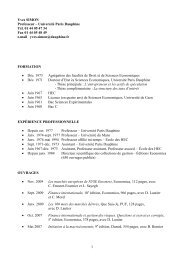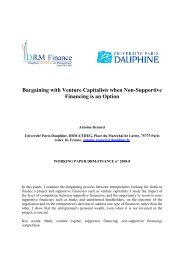Souad AJILI - CEREG - Université Paris-Dauphine
Souad AJILI - CEREG - Université Paris-Dauphine
Souad AJILI - CEREG - Université Paris-Dauphine
You also want an ePaper? Increase the reach of your titles
YUMPU automatically turns print PDFs into web optimized ePapers that Google loves.
ook to market and large stocks (HB). However, this positive relationship is reversed<br />
for low book to market portfolios because in this book to market group, low factor<br />
loading portfolios have, on average, monthly excess returns higher than high factor<br />
loading ones .<br />
Table 8.<br />
Average book to market and size of test portfolios<br />
The sample is composed of 197 French stocks. The four size-book to market portfolios are formed using<br />
the Fama and French methodology: we rank all stocks by their book to market ratio of December of<br />
the year (t−1) and their capitalization of June of year (t). Our database is Datastream. Each of the<br />
stocks in these four portfolios is then sorted into one of two sub-portfolios based on their HML loadings<br />
in the regression: R i − R f = α i + β Mkt (R Mkt − R f ) + β SMB R SMB + β HML R HML . Like Daniel<br />
and Titman, we use ex-ante observable information to estimate expected future HML factor loading of<br />
stocks. We regress each stock’s returns on the three factor portfolios for the period -42 to -7 relative<br />
to the portfolio formation date. We use the Fama and French factor portfolios with variable weights<br />
to estimate preformation factor loadings, as is described in section 2.2. At each yearly formation date,<br />
the average size and book to market for each portfolio is calculated using value weighting:<br />
1 ∑<br />
SZ t = ∑<br />
i ME MEi,t<br />
2<br />
i,t<br />
i<br />
1 ∑<br />
BM t = ∑<br />
i ME ME i,t BM i,t .<br />
i,t<br />
i<br />
Then at each point, and are divided by the median market equity and median book to market of French<br />
market. The two time series are then averaged to get numbers that are presented in the table below.<br />
Char. Prot.<br />
Factor Loading Portfolio<br />
BM SZ Low High<br />
Book to market relative to median<br />
L S 0.606 0.623<br />
L B 0.456 0.573<br />
H S 1.810 2.115<br />
H B 1.407 2.017<br />
Market equity relative to median<br />
L S 0.650 0.668<br />
L B 30.150 20.321<br />
H S 0.548 0.615<br />
H B 14.013 15.128<br />
The three factor risk model predicts that the high factor loading portfolios have<br />
higher average returns than low factor loading portfolios. However, Daniel and<br />
Titman (1997) explain this positive relation between mean excess returns and factor<br />
loadings as follows: when we sort stocks on the HML factor loading, we may pick<br />
up variation in the book to market ratio. Like them, we examine this possibility<br />
by calculating the average book to market ratios and the sizes of each of the 8<br />
portfolios. At each yearly formation date, the average book to market ratios and<br />
sizes, presented in table 8, are calculated relative to the median French market.<br />
16



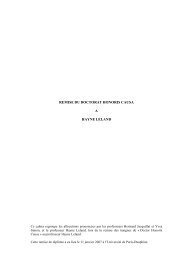

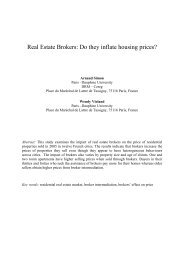
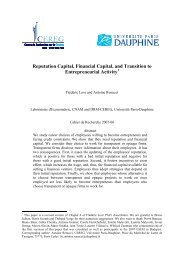

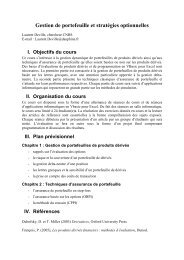

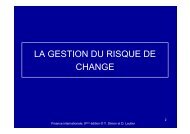
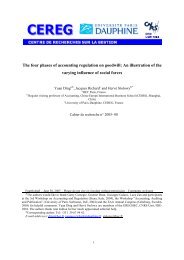
![& 6 ] ^ F ]^ - CEREG - Université Paris-Dauphine](https://img.yumpu.com/33326502/1/184x260/-6-f-cereg-universitac-paris-dauphine.jpg?quality=85)

